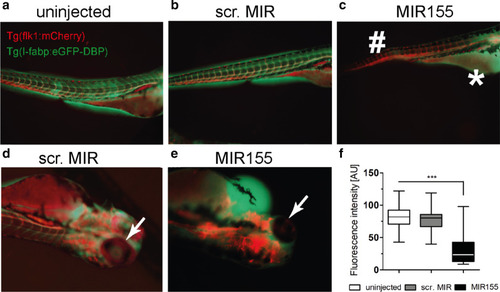
Functional consequences of MIR155 overexpression and inhibition in zebrafish. a–f Transgenic zebrafish larvae (Tg(flk1:mCherry)/Tg(I-fabp:eGFP-DBP) were used to assess the role of MIR155 in vivo. Uninjected larvae (n = 26), scrambled MIR injected (25 µM, n = 16) and MIR155 injected larvae (25 µM, n = 26) were analyzed at 96 h post-fertilization. a Phenotype analysis shows the eGFP-DBP fusion protein (green) predominantly within the mcherry-flk1 positive vasculature (red) in the uninjected larva. b Equivalent eGFP-DBP expression is being detected in the scrambled MIR injection group. c MIR155 overexpression leads to loss of eGFP-DBP (green) from the mcherry-flk1 positive vasculature (#) (red) and shows accumulation in the pericardium and yolk sac (*). d To quantify protein leakage, the eGFP-DBP content was measured by detection of eGFP-DBP in the retinal vasculature in scrambled and in e the MIR155 injected fish. In the retinal vasculature of the MIR155 zebrafish, the fluorescence is diminished as eGFP-DBP is not detectable (arrow). f Box and whisker plots showing a quantification of protein leakage that was performed by measurement of the maximum fluorescence intensity of eGFP-DBP in the retinal vasculature indicating a significant loss in the MIR155 injected fish (***p < 0.0001)
|

